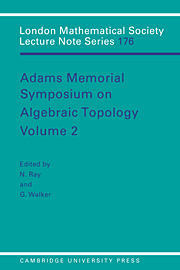Book contents
- Frontmatter
- Contents
- Preface
- Contents of Volume 1
- Programme of one-hour invited lectures
- Programme of contributed lectures
- Programme of Posters
- Participants in the Symposium
- Addresses of Contributors
- 1 Progress report on the telescope conjecture
- 2 On K*-local stable homotopy theory
- 3 Detruncating Morava K-theory
- 4 On the p-adic interpolation of stable homotopy groups
- 5 Some remarks on υ1 -periodic homotopy groups
- 6 The unstable Novikov spectral sequence for Sp(n), and the power series sinh−1(x)
- 7 Unstable Adams spectral sequence charts
- 8 On a certain localization of the stable homotopy of the space XΓ
- 9 Cooperations in elliptic homology
- 10 Completions of G-spectra at ideals of the Burnside ring
- 11 Theorems of Poisson, Euler and Bernouilli on the Adams spectral sequence
- 12 Algebras over the Steenrod algebra and finite H-spaces
- 13 The boundedness conjecture for the action of the Steenrod algebra on polynomials
- 14 Representations of the homology of BV and the Steenrod algebra I
- 15 Generic representation theory and Lannes' T-functor
- 16 Some chromatic phenomena in the homotopy of MSp
- 17 On a conjecture of Mahowald concerning bordism with singularities
- 18 Topological gravity and algebraic topology
15 - Generic representation theory and Lannes' T-functor
Published online by Cambridge University Press: 18 January 2010
- Frontmatter
- Contents
- Preface
- Contents of Volume 1
- Programme of one-hour invited lectures
- Programme of contributed lectures
- Programme of Posters
- Participants in the Symposium
- Addresses of Contributors
- 1 Progress report on the telescope conjecture
- 2 On K*-local stable homotopy theory
- 3 Detruncating Morava K-theory
- 4 On the p-adic interpolation of stable homotopy groups
- 5 Some remarks on υ1 -periodic homotopy groups
- 6 The unstable Novikov spectral sequence for Sp(n), and the power series sinh−1(x)
- 7 Unstable Adams spectral sequence charts
- 8 On a certain localization of the stable homotopy of the space XΓ
- 9 Cooperations in elliptic homology
- 10 Completions of G-spectra at ideals of the Burnside ring
- 11 Theorems of Poisson, Euler and Bernouilli on the Adams spectral sequence
- 12 Algebras over the Steenrod algebra and finite H-spaces
- 13 The boundedness conjecture for the action of the Steenrod algebra on polynomials
- 14 Representations of the homology of BV and the Steenrod algebra I
- 15 Generic representation theory and Lannes' T-functor
- 16 Some chromatic phenomena in the homotopy of MSp
- 17 On a conjecture of Mahowald concerning bordism with singularities
- 18 Topological gravity and algebraic topology
Summary
Introduction
I remember Frank Adams describing certain recent developments in topology as follows: It is the business of homotopy theorists to compute [X, Y], and, while traditionally X has been a finite complex, now we can let X = BG. This was, of course, initiated by H. Miller in [M], and is ongoing.
Underlying the topological theorems were some wonderful new results about H8* (V), the mod p cohomology of an elementary abelian p-group V, viewed as an object in the category of unstable modules over the Steenrod algebra Ap. These results were ultimately given an elegant treatment by J. Lannes, who considers the functor left adjoint to H* (V) ⊗. Many of us have learned the mantra “Tv is exact and takes tensor products to tensor products”. (Most people have been content to believe the survey [L1], but the nontrivial details have finally appeared in [L2].)
At the Manchester conference, I lectured on a representation theoretic framework for understanding Steenrod algebra “technology”, as in [HLS] and [K1]. Here I wish to give an exposition of Tv and its properties from this point of view.
The key observation is as follows. Let (q) be the category with objects functors
F: finite Fq -vector spaces → Fq -vector spaces,
where Fq is the field with q elements. Morphisms in (q) are the natural transformations.
- Type
- Chapter
- Information
- Adams Memorial Symposium on Algebraic Topology , pp. 235 - 262Publisher: Cambridge University PressPrint publication year: 1992
- 1
- Cited by



